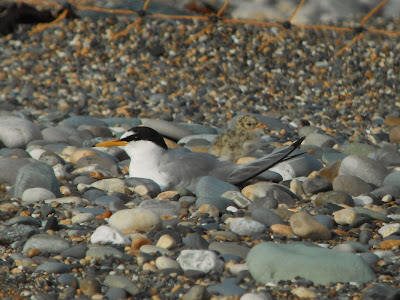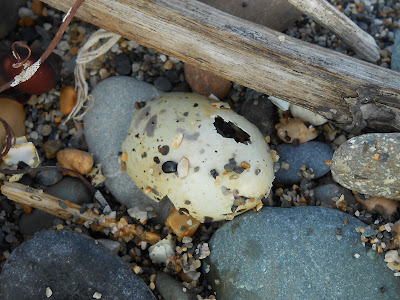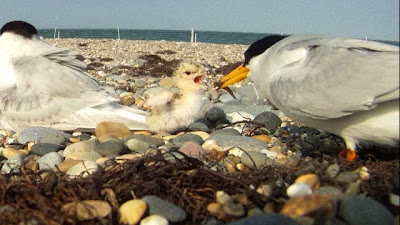The June Spring Tides which caused so much heartache in 2012 came & went this season without any hassle thanks to prevailing light-moderate Westerly winds. Furthermore, a good spell of dry, warm weather has ensured that the first group of chicks to hatch since Sat 22nd June have been treated to optimal conditions during their crucial first few days of life.
We've been
weighing & measuring each new brood regularly as well as
observing the species, size & frequency of fish brought in by the adults. Initial results are looking good with one chick in particular
jumping from 7.2 grams on the day of hatching to 18.55 grams three days
later! The parents of a brood of three have been kept busy & were
noted bringing in as many as 12 fish (mostly small sandeels) per hour yesterday evening!
The majority of the chicks are now very mobile & have been led by their parents away from their original nest scrape, out of the main area of fencing & onto the foreshore. This is normal behaviour & a sort of tern 'creche' will form along the mean high water mark over the coming weeks where feeding can be observed throughout the day. Access to the foreshore alongside the colony is still restricted in order to avoid any unwanted trampling so if you're planning on visiting the beach at Kilcoole please follow on site instructions as laid out by the wardens.
 |
| Monitoring chick growth & development...a tough job! © Niall Keogh |
|
 |
| Adult & chick © Niall Keogh |
 |
| Rare moment seeing a tern chick just after hatching © Niall Keogh |
It seems to be an odd year with regards potential predators. The 'usual suspects' such as Fox, Hedgehog, Hooded Crow & Rook have all been thin on the ground for the most part with very little corvid activity on the beach or in the estuary, just two Hedgehogs found at night along the coastal track (usually a good few more expected by now) & Cole reports just the one sighting of a Fox near the beach well to the North of the colony which legged it as soon as he saw it.
Saying that, we have experienced some losses to less familiar species, namely Oystercatcher & Sparrowhawk. A total of 3 nests with 2 eggs each were eaten by an Oystercatcher between 19th & 25th June. We have been closely observing all the Oycs in the vicinity & it would appear that the individual in question is a lone non-breeder which has been seen foraging in the tideline near the colony. Our resident breeding Oycs have taken no notice of any nesting tern nests near them all season & have proved invaluable as colony 'security', chasing away any potential avian predators that fly over the beach. In fact, they have also been chasing this lone Oyc off their territory & as such it hasn't been seen in quite a few days.
 |
| Little Tern eggshell after being poked & eaten by an Oystercatcher © Niall Keogh |
A male Sparrowhawk caught an adult tern at 05:30am on 20th June after which a pile of plucked tern feathers was found along the west boundary of the flexi-net fence. The first proven case of predation by Sparrowhawk at the Kilcoole Little Tern colony since 1997! It made a further six attempts on the colony over the next five days but luckily the terns & Oycs had caught on to the Sprawk's ambush tactics and promptly saw him off with great enthusiasm. The same can be said for the wardens who chased after it also!
 |
| Remains of an adult Little Tern after being caught & plucked by a male Sparrowhawk © Niall Keogh |
But aside from these unusual predation events, we're happy to report everything else is going well. Eggs are hatching on time, chicks are getting stuffed with fish, disturbance has been kept to a minimum & the support from the local public seems to be ever growing (lots of folk enjoying nice views of chicks lately!).
So as of this afternoon the scores on the shores are as follows: 37 active pairs with 36 chicks & 34 eggs left to hatch.
 |
| Not sure if anyone has told this chick that it will be another 3 weeks or more before it will fly. Hasn't stopped it from exercising its wings all the same! © Niall Keogh |












